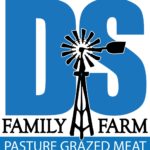Worried about what you are "really" eating? Have peace of mind with pasture grazed meats.
Annual Omega 6:3 Ratio Update
We first harvested grass-fed beef (what we call Pasture Grazed Beef) in 2015. Before harvesting our first beef, we researched the science of pasture-raised animals and how they were unique. One key indicator of beef raised on an all-grass diet is the resulting Omega 6:3 fatty acid ratio of the harvested meat. A low ratio of Omega 6:3 fatty acids indicates the animal was harvested off fresh growing green vegetation. When you see green growing vegetation, you are looking at highly perishable Omega 3 fatty acids. Green growing vegetation quickly withers and dries up (perishable) if cut off and the Omega 3 fats are gone. Plants use Omega 6 fatty acids in their seeds for long time storage. Seeds can lie in the ground for years with the Omega 6 fats just waiting to help nourish a newly sprouting plant.
Cattle harvested off green growing vegetation will have more Omega 3 fats in relation (ratio) to Omega 6 fats. More Omega 3 fats make for an overall lower Omega 6:3 ratio. Cattle harvested from a confined animal feeding operation (CAFO) fed ground-up corn and soybean seeds, will have more Omega 6 fats in their meat making the Omega 6:3 ratio higher.
What does that mean for human health?
We have written extensively about this topic, feel free to read back through some previous posts. In short, the Standard American Diet (SAD) contains more omega 6 fats than omega 3 fats. Both fats are important for human health, but over doing either omega 3 or omega 6 fats causes problems. Over the past 50 years we have had a huge public relations campaign that “VEGETABLE OILS” are good for us. Many food items, that use to be cooked in animal fats, are now cooked in “SEED FATS”. As explained above, seed fats are Omega 6 fats. We are simply over consuming Omega 6 fats.
What can we do to counter Seed Oils Omega 6 Fats?
First, stop cooking with “VEGETABLE OILS”. Vegetable Oil is a nice-sounding term describing seed oils or seed fats. Convert your cooking oils to Coconut or Olive oil or better yet cook in Lard (pig fat) or Tallow (beef fat). You will be amazed at how much better your food tastes using Lard or Tallow. If you were born before 1980, maybe you can remember how good fast food French fries use to taste when they were cooked in tallow!
After reducing your seed oil consumption, search out whole raw foods and be sure to include pasture grazed meats.
DS Family Farm 2022 Harvested Beef Omega 6:3 Results
This past year’s harvest data comes from our participation in the BioNutrient Beef Project. The Nutrient Density Metabolomics Lab at Utah State University, under the direction of Stephan van Vliet, Ph.D. is providing our Omega 6:3 ratio data this year. We look forward to receiving a full bio-nutrient analysis of our beef soon.
The fatty acid results show DS Family Farm Omega 6:3 Ratio = 1.83. The report compares our results to all grass-fed beef farms participating in the project. The average Omega 6:3 Ratio for all grass-fed beef samples = 2.79. In a review of our past results for Omega 6:3 ratios, over 9 past harvests, DS Family Farm beef has never shown an Omega 6:3 ratio above 2.4:1. It appears that we are providing a truly grass-fed product. If you are interested in trying grass-fed beef, try some of our Pasture Grazed Beef. The data shows our Pasture Grazed Beef has a lower Omega 6:3 ratio than the average grass-fed beef farm.
Summary From Utah State Concerning Omega 6:3 Ratio
Description: The ratio of omega-6 fatty acids divided by omega-3 fatty acids.
Potential Health Effects: A lower omega 6:3 ratio is typically considered beneficial. Lower levels means a higher abundance of omega-3 fatty acids. Randomized controlled trials suggest that beef with a low omega 6:3 ratio can increase omega-3 blood levels in consumers, which is generally considered beneficial for human health.
Doug’s added note: The reason a lower Omega 6:3 ratio is considered “beneficial”, in my opinion, is the Standard American Diet results in over consumption of omega 6 fatty acids. Anything you can do to reduce omega 6 consumption is probably a beneficial move for the health of most of Americans.





